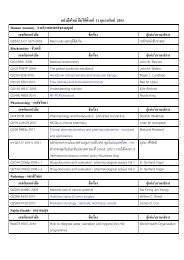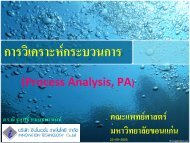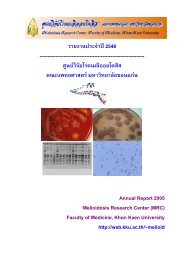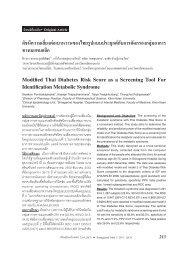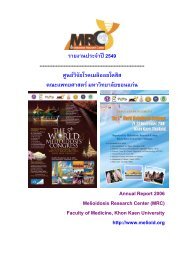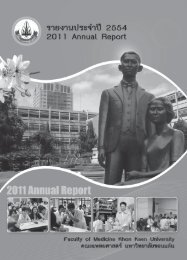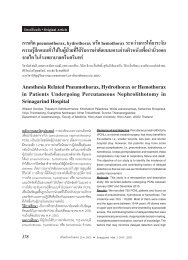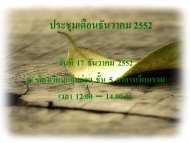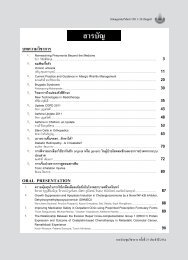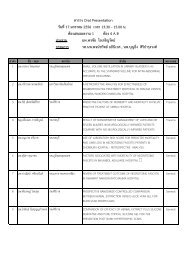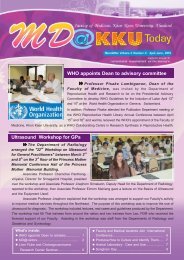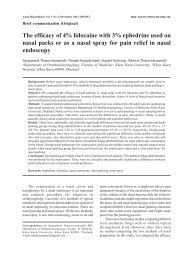Radiation dose from CT scanning: can it be reduced?
Radiation dose from CT scanning: can it be reduced?
Radiation dose from CT scanning: can it be reduced?
You also want an ePaper? Increase the reach of your titles
YUMPU automatically turns print PDFs into web optimized ePapers that Google loves.
Asian Biomedicine Vol. 5 No. 1 February 2011; 13-21Review articleDOI: 10.5372/1905-7415.0501.002<strong>Radiation</strong> <strong>dose</strong> <strong>from</strong> <strong>CT</strong> <strong>s<strong>can</strong>ning</strong>: <strong>can</strong> <strong>it</strong> <strong>be</strong> <strong>reduced</strong>?Panruethai Trinavarat a , Supika Kr<strong>it</strong>saneepaiboon b , Chantima Rongviriyapanich c , Pannee Visrutaratna d ,Jiraporn Srinakarin eaDepartment of Radiology, Faculty of Medicine, Chulalongkorn Univers<strong>it</strong>y, Bangkok 10330, Thailand.bDepartment of Radiology, Faculty of Medicine, Prince of Songkla Univers<strong>it</strong>y, Hat-Yai, Songkla 90110,Thailand. c Department of Radiology, Faculty of Medicine, Siriraj Hosp<strong>it</strong>al, Mahidol Univers<strong>it</strong>y, Bangkok10700, Thailand. d Department of Radiology, Faculty of Medicine, Chiang Mai Univers<strong>it</strong>y, ChiangMai 50000, Thailand. e Department of Radiology, Faculty of Medicine, Khon Kaen Univers<strong>it</strong>y, KhonKaen 40002, Thailand<strong>CT</strong> has <strong>be</strong>en used to save many patients’ lives and the demand for <strong>CT</strong> is still increasing. At the same time,there has <strong>be</strong>en increasing concern of the probabil<strong>it</strong>y of <strong>can</strong>cer induction by <strong>CT</strong> radiation. It is necessary foreveryone involved in <strong>CT</strong> <strong>s<strong>can</strong>ning</strong>, particularly physicians who have to communicate w<strong>it</strong>h patients when planninga <strong>CT</strong> s<strong>can</strong>, to have a basic knowledge of the <strong>CT</strong> radiation <strong>dose</strong> and <strong>it</strong>s potential adverse effects. We haveundertaken a systematic review of the l<strong>it</strong>eratures to document the radiation <strong>dose</strong> <strong>from</strong> <strong>CT</strong>, the lifetime <strong>can</strong>cer risk<strong>from</strong> <strong>CT</strong> exposure, <strong>CT</strong> <strong>dose</strong> parameters, the internationnal <strong>CT</strong> diagnostic reference levels, and the use andlim<strong>it</strong>ation of the <strong>CT</strong> effective <strong>dose</strong>. In add<strong>it</strong>ion, we conducted a brief survey of the use of <strong>CT</strong> s<strong>can</strong> in someunivers<strong>it</strong>y hosp<strong>it</strong>als in Thailand and estimated current <strong>CT</strong> <strong>dose</strong>s at these hosp<strong>it</strong>als. Our review and surveysuggests that <strong>CT</strong> <strong>s<strong>can</strong>ning</strong> provides a great <strong>be</strong>nef<strong>it</strong> in medicine but <strong>it</strong> also <strong>be</strong>comes the major source of X-rayexposure. <strong>Radiation</strong> <strong>dose</strong>s <strong>from</strong> a <strong>CT</strong> s<strong>can</strong> are much higher than most conventional radiographic procedures. Thisraises concerns about the carcinogenic potentials. We encourage every <strong>CT</strong> un<strong>it</strong> to adhere to the InternationalGuidelines of <strong>CT</strong> <strong>dose</strong> parameter references. Our preliminary survey <strong>from</strong> some univers<strong>it</strong>y hosp<strong>it</strong>als in Thailandrevealed that <strong>CT</strong> radiation <strong>dose</strong>s are w<strong>it</strong>hin acceptable standard ranges. However, the justification for utilizationof <strong>CT</strong> s<strong>can</strong>s should also <strong>be</strong> required and mon<strong>it</strong>ored. The importance of adequate communication <strong>be</strong>tween attendingphysician and consulting radiologist is stressed.Keywords: Computer S<strong>can</strong>ning, <strong>dose</strong> calculation, radiation risk, state of the art in Thai univers<strong>it</strong>y hosp<strong>it</strong>alsComputer assisted radiologic <strong>s<strong>can</strong>ning</strong> (<strong>CT</strong>) is atechnology that was first developed in 1972, only fourdecades ago. It is an enormous advance in medicaldiagnostics but like most medical advances presentsboth a financial cost and carries some risks of adverseside effects. Concerns regarding radiation have <strong>be</strong>enrising along w<strong>it</strong>h the tendency to also use <strong>CT</strong> inpatients where <strong>it</strong> is inappropriate and other forms ofimaging are more cost-risk-<strong>be</strong>nef<strong>it</strong> effective. Afterthe development of multi-detector <strong>CT</strong> (MD<strong>CT</strong>) in1998, <strong>CT</strong> examinations worldwide are increasing inadult and pediatric patients. A signifi<strong>can</strong>t percentageCorrespondence to: Panruethai Trinavarat, MD, Departmentof Radiology, Faculty of Medicine, Chulalongkorn Univers<strong>it</strong>y,1873 Rama IV, Pathumwan, Bangkok 10330, Thailand.E-mail: pantrinavarat@hotmail.comof these have multiple <strong>CT</strong> s<strong>can</strong>s [1-4]. <strong>CT</strong>, as well asconventional radiographs, uses X-ray to create animage. X-ray is ionizing radiation, so <strong>it</strong> <strong>can</strong> causebiological adverse side effects [5]. The highest concernis an increasing risk of <strong>can</strong>cer and w<strong>it</strong>h relativelysmaller probabil<strong>it</strong>y for hered<strong>it</strong>ary diseases only whengonads are in direct <strong>be</strong>am. From available data, <strong>it</strong> iswidely <strong>be</strong>lieved that there is no threshold <strong>dose</strong> for thisstochastic type of radiation effect. The other type ofradiation effect has a threshold <strong>dose</strong> (deterministiceffect) and <strong>can</strong> cause redness of the skin, epilation,or desquamation when there is exposure above thethreshold level. Opacification of the eye lens andcataract <strong>can</strong> develop when the orb<strong>it</strong>-absor<strong>be</strong>d <strong>dose</strong> isabove the threshold, but this has so far not <strong>be</strong>endocumented in patients undergoing <strong>CT</strong> s<strong>can</strong>.
14P. Trinavarat, et al.Diagnostic radiology does not usually use a <strong>dose</strong>that <strong>can</strong> cause deterministic effects, but <strong>it</strong> could<strong>be</strong> found in interventional radiology [6] orcardioangiography [7] or accidentally as an over <strong>dose</strong>in <strong>CT</strong> imaging [8]. <strong>Radiation</strong> used in diagnosticradiology is of low-level and overall the <strong>be</strong>nef<strong>it</strong>sexceed the risks for the patients. Repeated routinechest X-rays and mammography are performedworldwide. However, are we all aware of the higherradiation <strong>dose</strong> in <strong>CT</strong> chest comparing to a chestX-ray? Is there an increased risk to develop <strong>can</strong>cerafter having multiple <strong>CT</strong> s<strong>can</strong>s? If the answer is yes,what are the risks?The probabil<strong>it</strong>y of <strong>can</strong>cer development increaseswhen there is an increasing patient’s cumulativeradiation <strong>dose</strong> (Table 1). Conventional radiographsentail a very low risk that one needs not worry aboutso long as the examination is justified. A single PAviewchest radiograph in adult gives a radiation<strong>dose</strong> of about 0.02 milli-Sieverts (mSv) to the patient(Table 2) [9]. However, for a chest <strong>CT</strong>, the <strong>dose</strong> isabout 7 mSv [9], which is about 350 times that of achest radiograph. The <strong>can</strong>cer risk may <strong>be</strong> estimated,based on a nominal probabil<strong>it</strong>y coefficient for <strong>can</strong>cerinduction of 5.5% per Sv [10], and <strong>can</strong> <strong>be</strong> expressedas a risk ratio for easier communication [11]. Forexample, if a <strong>CT</strong> s<strong>can</strong> of the whole thoracic spineresults in an effective <strong>dose</strong> of 10 mSv, using the <strong>can</strong>cerrisk coefficient of 5.5 % per Sv, the estimated <strong>can</strong>cerrisk will <strong>be</strong> 5.5x10 -4 , given a risk ratio of 1 in 1800[11].Table 1. Effective <strong>dose</strong> <strong>from</strong> diagnostic radiology and the lifetime risk of <strong>can</strong>cer [12].Procedure Effective Cancer risk<strong>dose</strong> (mSv)Radiographs of chest, extrem<strong>it</strong>ies < 0.1 1 in 1,000,000Radiographs of lumbar spine, abdomen 1-5 1 in 10,000IVP<strong>CT</strong> head and neckBarium enema 5-20 1 in 2,000<strong>CT</strong> s<strong>can</strong>s of chest or abdomenNuclear cardiogramCardiac angiogram<strong>Radiation</strong> <strong>from</strong> natural background 2.4 1 in 5,000Table 2. Effective <strong>dose</strong> <strong>from</strong> different examinations in diagnostic radiology.Examination Average Examination Averageeffectiveeffective<strong>dose</strong> (mSv)<strong>dose</strong> (mSv)Chest X-ray (PA) 0.02 <strong>CT</strong> chest 7Chest X-ray (PA and lat) 0.1 <strong>CT</strong> chest for pulmonary 15Abdomen 0.7 embolismPelvis 0.6 <strong>CT</strong> abdomen 8Skull 0.1 <strong>CT</strong> pelvis 6Lumbar spine 1.5 <strong>CT</strong> three-phase of liver 15Mammography 0.4 <strong>CT</strong> skull 2IVP 3 <strong>CT</strong> neck 3Upper GI study 6 Coronary <strong>CT</strong> angiography 16Barium enema 8 Virtual colonoscopy 10Selected data <strong>from</strong> [9]
Vol. 5 No. 1February 2011<strong>Radiation</strong> <strong>dose</strong> <strong>from</strong> <strong>CT</strong> <strong>s<strong>can</strong>ning</strong>15Data <strong>from</strong> survivors of atomic bombing inHiroshima and Nagasaki [13, 14] were used to createa risk model. <strong>Radiation</strong> <strong>dose</strong>s <strong>from</strong> <strong>CT</strong> are usuallylower than the <strong>dose</strong> to those survivors, but this mightnot <strong>be</strong> true when multiple <strong>CT</strong> s<strong>can</strong>s have <strong>be</strong>enperformed. Many reviews in the l<strong>it</strong>erature have datarelating <strong>can</strong>cer risk to patients receiving diagnosticradiation [15-19]. These relate to breast <strong>can</strong>cer andfluoroscopy of the chest in tu<strong>be</strong>rculosis patients, tofrequent radiographs of the spine in scoliosis patients,to <strong>can</strong>cer of salivary glands and thyroid gland andimaging of the head and neck region, and to leukemiarelated to frequent radiation exposure in children.Linear extrapolation and linear quadratic extrapolationare proposed to predict the solid <strong>can</strong>cer and leukemiaincidence for lower radiation <strong>dose</strong>s [20].<strong>CT</strong> s<strong>can</strong>s have <strong>be</strong>come the major source ofhuman exposure to diagnostic X-rays as they representthe highest share of collective <strong>dose</strong>s <strong>from</strong> medicalexposures. This is the reason why there is nowconcern about the increasing use of <strong>CT</strong>, particularlyin pediatric patients whose tissues are more prone toradiation effects (Fig. 1) [21]. <strong>CT</strong> in children should<strong>be</strong> performed only when the <strong>be</strong>nef<strong>it</strong> is clearly abovethe risk. It must <strong>be</strong> performed only to the arearequired, w<strong>it</strong>h lim<strong>it</strong>ed phases of <strong>s<strong>can</strong>ning</strong>, and w<strong>it</strong>hthe lowest radiation that still gives diagnostic imagequal<strong>it</strong>y. There is also a higher risk of <strong>can</strong>cer in femalesthan in males. This <strong>can</strong> <strong>be</strong> explained by smaller femalesize and different pos<strong>it</strong>ion of radiosens<strong>it</strong>ive organs [23].In USA, where approximately 72 million <strong>CT</strong> s<strong>can</strong>swere performed in 2007, <strong>it</strong> was estimated thatapproximately 29,000 future <strong>can</strong>cers would develop[1]. The largest contribution would <strong>be</strong> <strong>from</strong> <strong>CT</strong>abdomen and pelvis, followed by chest <strong>CT</strong>, head <strong>CT</strong>,and <strong>CT</strong> angiography [1]. Approximately 60% of the<strong>CT</strong> s<strong>can</strong>s were performed in females and two-thirdsof the projected <strong>can</strong>cers would occur in females [1].We should know whether the <strong>CT</strong> <strong>dose</strong> is optimalby looking at <strong>CT</strong> <strong>dose</strong> parameters. However, <strong>it</strong> isconfusing when talking about <strong>dose</strong> parameters<strong>be</strong>cause different X-ray modal<strong>it</strong>ies have different <strong>dose</strong>parameters and a single modal<strong>it</strong>y may have more thanone parameter. Dose parameters for <strong>CT</strong> are “<strong>CT</strong> <strong>dose</strong>index - <strong>CT</strong>DI” and “<strong>dose</strong> length product-DLP”.On newly released MD<strong>CT</strong> machines, <strong>CT</strong>DI isdisplayed on the mon<strong>it</strong>or console, so that thetechnologists performing the s<strong>can</strong> will see <strong>it</strong> <strong>be</strong>foreand after the s<strong>can</strong>. It is also used to detect whetherthe radiation <strong>dose</strong> is w<strong>it</strong>hin the diagnostic referencelevels (DRLs). DRLs, using the third-quartile (75percentile), of the <strong>CT</strong>DI and DLP values have <strong>be</strong>enproposed as guidelines <strong>from</strong> the European commission[24, 25]. Many countries have or are going to have<strong>CT</strong> DRLs of their own [26-29] while others use theDRLs of the European Commission and of the Un<strong>it</strong>edKingdom [30] for comparing and adjusting the <strong>CT</strong><strong>dose</strong>s (Table 3). However, <strong>CT</strong> <strong>dose</strong>s seem to <strong>be</strong>lower in updated reports, <strong>be</strong>cause of concern forradiation and advances in <strong>CT</strong> technology [31].Technologists and radiologists should produce andinterpret images of acceptable qual<strong>it</strong>y, not of the highestqual<strong>it</strong>y <strong>from</strong> very high <strong>dose</strong> s<strong>can</strong>s, which would onlyincrease the radiation <strong>dose</strong>. Therefore, physicians needto understand that <strong>it</strong> is not necessary to get the highestqual<strong>it</strong>y image, but <strong>it</strong> is necessary to obtain good enoughqual<strong>it</strong>y for making a reliable diagnosis and not exposethe patient to unnecessary add<strong>it</strong>ional radiation and<strong>can</strong>cer risks.Fig. 1 Age and sex effect on risk of <strong>can</strong>cer when receiving ionizing radiation [22].
16P. Trinavarat, et al.Table 3. Diagnostic reference levels (DRLs) for MD<strong>CT</strong> in adults.<strong>CT</strong> examination s<strong>can</strong> region <strong>CT</strong>DI w(mGy) <strong>CT</strong>DI v(mGy) DLP (mGy cm)UK European UK European UK EuropeanMS<strong>CT</strong> SS<strong>CT</strong> MS<strong>CT</strong> MS<strong>CT</strong> MS<strong>CT</strong> SS<strong>CT</strong>Head (acute posterior fossa 110 - 100 - - -stroke) cerebrum 65 - 65 - - -whole exam - 60 - 60 930 1050Thorax general lung 18 30 13 - - -liver 19 - 14 - - -whole exam - - - 10 580 650Thorax HR<strong>CT</strong> whole exam 50 35 7 10 170 280Abdomen whole exam 20 35 14 25 470 900(liver metastasis)Abdomen&pelvis whole exam 20 35 14 15 560 780(abscess)Chest, abdomen lung 16 30 12 - - -& pelvis abdomen & pelvis 20 35 14 - - -(lymphoma) whole exam - - - - 940 -Diagnostic reference level <strong>from</strong> Un<strong>it</strong>ed Kingdom in 2003 reported in 2006 [30]Diagnostic reference level <strong>from</strong> European guidelines published in 1999 [24]<strong>CT</strong>DI and DLP are <strong>dose</strong> parameters for QC.However, for assessment of <strong>can</strong>cer risks, an individualorgan-specific absor<strong>be</strong>d <strong>dose</strong> is more appropriate. Theeffective <strong>dose</strong> is another <strong>dose</strong> quant<strong>it</strong>y that is usedfor protection purposes [32], and <strong>it</strong> allows comparisonacross different types of <strong>CT</strong> studies and <strong>be</strong>tween <strong>CT</strong>and other imaging studies. So <strong>it</strong> is frequently mentionedin medical l<strong>it</strong>eratures.To obtain the effective <strong>dose</strong>, there are manymethods. It must <strong>be</strong> understood that most commonlyused methods calculate effective <strong>dose</strong> to a phantomrather than a patient. The most accurate butsophisticated methods need the help of medicalphysicists. Most of developing countries have notenough medical physicists. The easiest way tocalculate the effective <strong>dose</strong> for practical purpose isto multiply the displayed value of DLP by theconversion factor (conversion coefficient, or effective<strong>dose</strong> per DLP). The conversion factor is area-specifi<strong>can</strong>d age-specific, so we need a set of conversionfactors (Table 4). However, to make sure of the result,the displayed DLP needs to <strong>be</strong> verified by the QCprocess that needs <strong>s<strong>can</strong>ning</strong> a cylindrical acrylicphantom. These conversion factors are derived <strong>from</strong>a standard patient size (70kg man), <strong>from</strong> the estimatedradio-sens<strong>it</strong>iv<strong>it</strong>y of each organ (tissue weightingfactor), and <strong>from</strong> the assumed organs <strong>be</strong>ing includedin the <strong>s<strong>can</strong>ning</strong> volume. These num<strong>be</strong>rs are estimatevalid for a patient matching phantom and thus, willhave large error when applied to patients w<strong>it</strong>h higheror lower body weight.Table 4. Conversion factors specific for <strong>s<strong>can</strong>ning</strong> area and age group [30].Region of bodyEffective <strong>dose</strong> per DLP (mSv/mGy . cm) by agePediatricsAdult0 year old 1 year old 5 year old 10 year old (70 kg)Head 0.011 0.0067 0.0040 0.0032 0.0021Neck 0.017 0.012 0.011 0.0079 0.0059Head and Neck 0.013 0.0085 0.0057 0.0042 0.0031Chest 0.039 0.026 0.018 0.013 0.014Abdomen and pelvis 0.049 0.030 0.020 0.015 0.015Trunk 0.044 0.028 0.019 0.014 0.015
Vol. 5 No. 1February 2011<strong>Radiation</strong> <strong>dose</strong> <strong>from</strong> <strong>CT</strong> <strong>s<strong>can</strong>ning</strong>17Many author<strong>it</strong>ies worry about the application ofthe effective <strong>dose</strong> [11, 21, 32, 33]. They suggest that<strong>it</strong> is used for reference values for protection purposes,not for detailed assessments of <strong>dose</strong> and the risk toan individual. As the ICRP revised tissue-weightingfactor in 2007, there is a suggestion that DLP toeffective <strong>dose</strong> conversion coefficient should <strong>be</strong>reassessed <strong>be</strong>cause <strong>it</strong> underestimates the effective<strong>dose</strong> [34].The King Chulalongkorn Memorial Hosp<strong>it</strong>al(KCMH) performed <strong>CT</strong> examinations on 1286patients at 1,402 vis<strong>it</strong>s for 1576 s<strong>can</strong>ned areas <strong>be</strong>tweenJune 1 and 30, 2010. Mean age of the patients was 55years. Males and females were nearly equal. Sixtysubjects (4.7%) were under the age of 15.In 1225 adults w<strong>it</strong>h 1504 s<strong>can</strong>ned areas, the fivemajor types of performed <strong>CT</strong> were whole abdomen(abdomen and pelvis) in 351, chest in 278, upperabdomen in 260, brain w<strong>it</strong>hout contrast enhancementin 241, and brain w<strong>it</strong>h contrast enhancement in 142.These accounted for 84.6% of all <strong>CT</strong>.<strong>CT</strong>DI w(sequential s<strong>can</strong> for brain <strong>CT</strong>), <strong>CT</strong>DI v(helical s<strong>can</strong> for body <strong>CT</strong>), DLP, and <strong>s<strong>can</strong>ning</strong>parameters <strong>from</strong> adult patients <strong>be</strong>tween June 1 and 7,2010 were retrospectively reviewed <strong>from</strong> PictureArchiving and the Communications System. Theeffective <strong>dose</strong> for each type of <strong>CT</strong> was calculated.The mean values of <strong>dose</strong> parameters in KCMH werecompared to four univers<strong>it</strong>y hosp<strong>it</strong>als (Table 5) inThailand and DRLs of the UK and EuropeanCommission (Table 6-9).Table 5. <strong>CT</strong> <strong>dose</strong> data <strong>from</strong> five univers<strong>it</strong>y hosp<strong>it</strong>als in Thailand.Hosp<strong>it</strong>al Univers<strong>it</strong>y Hosp<strong>it</strong>al <strong>CT</strong> exams <strong>CT</strong> s<strong>can</strong>nerssize (<strong>be</strong>ds) in 2009King Chulalongkorn Chulalongkorn Univers<strong>it</strong>y 1439 15800 Somatom Sensation 4Memorial Hosp<strong>it</strong>al Somatom Sensation 16Siriraj Hosp<strong>it</strong>al Mahidol Univers<strong>it</strong>y 2232 31035 GE Light speedSomatom Defin<strong>it</strong>ionMaharaj Nakorn Chiang Mai Univers<strong>it</strong>y 1475 16118 Somatom Defin<strong>it</strong>ionChiang Mai Hosp<strong>it</strong>alSrinagarind Hosp<strong>it</strong>al Khon Kaen Univers<strong>it</strong>y 808 13379 Philips 128Songklanagarind Prince of Songkla 853 17855 Brilliance 64Hosp<strong>it</strong>al Univers<strong>it</strong>yTable 6. Mean values of <strong>CT</strong>DI, DLP, and E <strong>from</strong> <strong>CT</strong> s<strong>can</strong> in adult <strong>CT</strong> brain <strong>from</strong> five univers<strong>it</strong>y hosp<strong>it</strong>alsin Thailand, comparing w<strong>it</strong>h DRLs for MS<strong>CT</strong> of UK and European commission.<strong>CT</strong> brain A B C D E DRLsUKECNC Num<strong>be</strong>r 43 14 10 7 9<strong>CT</strong>DI w60/47 59 56 60 45 110/65 60DLP 817 998 974 1526 1089 930E 1.7 2.1 2.0 3 2.3NC+C Num<strong>be</strong>r 35 5 10 19 27<strong>CT</strong>DI w61/47 60 56 60 46DLP 1665 2653 1948 2700 2045E 3.5 5.57 4.1 5.67 4.2All Num<strong>be</strong>r 78 19 40 26 36E 2.5 3.0 3.1 5 3.8
18P. Trinavarat, et al.Table 7. Mean values of <strong>CT</strong>DI, DLP, and E <strong>from</strong> <strong>CT</strong> s<strong>can</strong>s in adult <strong>CT</strong> chest <strong>from</strong> five univers<strong>it</strong>y hosp<strong>it</strong>alsin Thailand comparing w<strong>it</strong>h DRLs for MS<strong>CT</strong> of UK and European commission.<strong>CT</strong> chest A B C D E DRLsUKECC Num<strong>be</strong>r 48 - 14 - 32<strong>CT</strong>DI v8.0 - 9.8 - 8.6 13 10DLP 306 - 410 - 355 580 650E 4.3 - 5.74 - 4.97NC+C Num<strong>be</strong>r 11 6 13 19 16<strong>CT</strong>DI v8.2 10.11 9.3/11.2 6.6/13.2 11.77DLP 636 711 156/450 718 742E 8.9 10.0 8.5 10.1 10.4All Num<strong>be</strong>r 59 6 27 19 48E 5.1 10 7.1 10.1 6.8Table 8. Mean values of <strong>CT</strong>DI, DLP, and E <strong>from</strong> <strong>CT</strong> s<strong>can</strong>s in adult <strong>CT</strong> upper abdomen w<strong>it</strong>h intravenouscontrast material <strong>from</strong> five univers<strong>it</strong>y hosp<strong>it</strong>als in Thailand comparing w<strong>it</strong>h DRLs for MS<strong>CT</strong> ofUK and European commission.<strong>CT</strong> upper abdomen A B C D E DRLsUKNum<strong>be</strong>r 70 24 33 43 16Venous phase <strong>CT</strong>DI v12.4 13.8 11.7 15.6 10.4 14 25DLP 380 395 323 - 316 470 900E 5.7 5.9 4.8 - 4.7No. of phases 3.4 2.7 3.5 2.8 3.1Whole exam DLP 1294 1132 1011 1149 1064E 19.4 17 15.2 17.2 16.9E<strong>CT</strong>able 9. Mean values of <strong>CT</strong>DI, DLP, and E <strong>from</strong> <strong>CT</strong> s<strong>can</strong> in adult <strong>CT</strong> whole abdomen <strong>from</strong> five univers<strong>it</strong>yhosp<strong>it</strong>als in Thailand comparing w<strong>it</strong>h DRLs for MS<strong>CT</strong> of UK and European commission.<strong>CT</strong> whole abdomen A B C D E DRLsUKNum<strong>be</strong>r 77 3 63 39 77Venous phase <strong>CT</strong>DI v12.3 13.9 11.9 17.9 11.3 14 15DLP 608 600 544 - 552 560 780E 9.1 9 8.2 - 8.3No. of phases 3.5 3 2.4 2.7 2.65Whole exam DLP 1662 1507 971 1742 1131E 24.9 22.6 14.7 26.1 18.4EC
Vol. 5 No. 1February 2011<strong>Radiation</strong> <strong>dose</strong> <strong>from</strong> <strong>CT</strong> <strong>s<strong>can</strong>ning</strong>19These data show a wide range of <strong>CT</strong> <strong>dose</strong>s<strong>be</strong>tween hosp<strong>it</strong>als in Thailand for each type of <strong>CT</strong>s<strong>can</strong>. The effective <strong>dose</strong> of <strong>CT</strong> brain ranges <strong>from</strong>2.5-5 mSv, <strong>CT</strong> chest <strong>from</strong> 5.1-10.1 mSv, <strong>CT</strong> upperabdomen <strong>from</strong> 15.2-19.4 mSv, and <strong>CT</strong> wholeabdomen <strong>from</strong> 14.7-26.1 mSv.W<strong>it</strong>h multiple s<strong>can</strong>s to the same area (pre contrastand post contrast s<strong>can</strong>s) in one examination, the patient<strong>dose</strong> increased to double when the same <strong>s<strong>can</strong>ning</strong>parameters and same s<strong>can</strong> length were used. Singleseries of non-contrast <strong>CT</strong> brain may <strong>be</strong> adequate forpatients w<strong>it</strong>h specific clinical indications. This wasapplied in more than half of <strong>CT</strong> brains in Hosp<strong>it</strong>als Aand B. As non-enhanced <strong>CT</strong> chest usually givesinadequate information, Hosp<strong>it</strong>als A and E prefer postenhanced <strong>CT</strong> chest, and Hosp<strong>it</strong>al C performed a lim<strong>it</strong>edlength of pre contrast s<strong>can</strong> to reduce the unnecessaryradiation.The high total <strong>dose</strong> is more obvious w<strong>it</strong>h <strong>CT</strong>abdomen, where the <strong>s<strong>can</strong>ning</strong> area is long (25 cm forupper abdomen and 45 cm for the whole abdomen).There is a high conversion coefficient (many organsw<strong>it</strong>h high tissue weighting factors in the abdomen)and multiple phases of <strong>s<strong>can</strong>ning</strong> (depending on clinicalquery). The high <strong>dose</strong> setting is seen in high <strong>CT</strong>DI of<strong>CT</strong> abdomen in Hosp<strong>it</strong>al D. Multiphase s<strong>can</strong> explainshigh <strong>dose</strong> for <strong>CT</strong> abdomen in Hosp<strong>it</strong>al A.Comparing <strong>dose</strong> parameters in Thailand to DRLs<strong>from</strong> the UK and European Commission, we foundthat mean <strong>CT</strong>DI values in Thailand were not abovetheir level. However, mean DLP value of some typesof <strong>CT</strong> <strong>s<strong>can</strong>ning</strong> in many hosp<strong>it</strong>als was above thelevels. This is likely <strong>from</strong> greater extension of the s<strong>can</strong>length. Orb<strong>it</strong>s and maxillary sinuses are mostlyincluded in brain-s<strong>can</strong>ned areas including the sens<strong>it</strong>iveeye lenses.Patient’s information is a necessary part inplanning a proper <strong>CT</strong> s<strong>can</strong>, particular the num<strong>be</strong>rs of<strong>s<strong>can</strong>ning</strong> phases. Discussion <strong>be</strong>tween physician andradiologist <strong>be</strong>forehand may obviate unnecessary<strong>s<strong>can</strong>ning</strong> phases or may move the patient to anothermore appropriate imaging modal<strong>it</strong>y. W<strong>it</strong>h inadequatecommunication <strong>be</strong>tween attending doctor andradiologist, there is a tendency to over s<strong>can</strong>, <strong>be</strong>causethe radiologist does not want to miss an importantfinding or to reschedule the patient for add<strong>it</strong>ional<strong>s<strong>can</strong>ning</strong>.<strong>CT</strong> <strong>dose</strong> data in this article were lim<strong>it</strong>ed to fiveunivers<strong>it</strong>y hosp<strong>it</strong>als but showed substantial variationin <strong>dose</strong>s across inst<strong>it</strong>utions. The authors suspect thatresults would <strong>be</strong> even more variable if hosp<strong>it</strong>als ofMinistry of Public Health and private hosp<strong>it</strong>als wereincluded in this survey. This implies need foroptimization to ensure that patients are given only the<strong>dose</strong> required for obtaining image of diagnostic qual<strong>it</strong>yand no more.<strong>CT</strong> parameter settings in Thailand are usuallyperformed by specialists trained <strong>from</strong> <strong>CT</strong> vendors w<strong>it</strong>hthe acceptance of image qual<strong>it</strong>y by radiologists as aforemost consideration. General radiologists may havelim<strong>it</strong>ed knowledge regarding radiation <strong>dose</strong>calculation. A national survey of the cond<strong>it</strong>ion of the<strong>CT</strong> s<strong>can</strong>ners and patient <strong>dose</strong> data by the authorizedagency (Department of Medical Sciences, Ministryof Public Health) is needed. Medical physicists indiagnostic radiology are not readily available, even insome univers<strong>it</strong>y hosp<strong>it</strong>als. Radiology professionalorganizations, such as the Royal College ofRadiologists, Society of Medical Physicists, and Societyof Radiological Technologists, should take part incontinuing educational courses and help to standardize<strong>CT</strong> <strong>dose</strong> throughout the country as well as assurequal<strong>it</strong>y of the machines. Above all, the inappropriateutilization of <strong>CT</strong> for diagnosis that <strong>can</strong> <strong>be</strong> arrived byother methods must <strong>be</strong> discouraged.Conclusion<strong>CT</strong> <strong>s<strong>can</strong>ning</strong> provides a great <strong>be</strong>nef<strong>it</strong> in medicinebut <strong>it</strong> also <strong>be</strong>comes the major source of X-ray exposure.<strong>Radiation</strong> <strong>dose</strong>s <strong>from</strong> a <strong>CT</strong> s<strong>can</strong> are much higher thanmost conventional radiographic procedures. This raiseconcerns about the carcinogenic potentials. Therefore,we encourage every <strong>CT</strong> un<strong>it</strong> to adhere to theInternational Guidelines of <strong>CT</strong> <strong>dose</strong> parameterreferences. It is comforting to learn that the radiation<strong>dose</strong>s of <strong>CT</strong> s<strong>can</strong> procedures <strong>from</strong> some univers<strong>it</strong>yhosp<strong>it</strong>als in Thailand are w<strong>it</strong>hin acceptable standardranges. We encourage the development of amechanism in every <strong>CT</strong> un<strong>it</strong> to ensure that thejustification for utilization of <strong>CT</strong> s<strong>can</strong>s is required andmon<strong>it</strong>ored.The authors have no conflict of interest to report.
20P. Trinavarat, et al.Appendix <strong>Radiation</strong> protection glossary<strong>Radiation</strong> <strong>dose</strong>*General term applied to the quant<strong>it</strong>y of radiation received by a body where the radiationinteracts.Absor<strong>be</strong>d <strong>dose</strong>*The quant<strong>it</strong>y of energy imparted to un<strong>it</strong> mass of matter (such as tissue or organ) byionizing radiation. Un<strong>it</strong> Gray (Gy). 1 Gy = 1 joule per kilogram.Equivalent <strong>dose</strong>*Different types of radiation have different radiation qual<strong>it</strong>ies resulting in different degreeof biological damage. Equivalent <strong>dose</strong> is obtained by multiplying the Absor<strong>be</strong>d Dose bya <strong>Radiation</strong> Weighting (qual<strong>it</strong>y) factor. Un<strong>it</strong> Sieverts (Sv).Effective <strong>dose</strong>*Different tissues/organs have different degree of sens<strong>it</strong>iv<strong>it</strong>y to radiation stochasticeffect. Effective <strong>dose</strong> is obtained by multiplying the Equivalent Dose by TissueWeighting Factor. The resulting quant<strong>it</strong>y <strong>can</strong> <strong>be</strong> used to express detriment to the wholebody as a summation of several organ <strong>dose</strong>s. Un<strong>it</strong> Sieverts (Sv). CollectiveCollective effective <strong>dose</strong>* It is derived <strong>from</strong> summing the individual effective <strong>dose</strong>s w<strong>it</strong>hin an exposure population.This quant<strong>it</strong>y has <strong>be</strong>en used to assess overall detriment and therefore as an aid todecision making techniques in optimizing radiation protection.Tissue weighting factor* The factor takes account of the different sens<strong>it</strong>iv<strong>it</strong>ies of different organs and tissues forinduction of probabilistic effects <strong>from</strong> exposure to ionizing radiation (principally inductionof <strong>can</strong>cer).Stochastic effect*It represents radiation harm for which there is no threshold. Even the smallest quant<strong>it</strong>yof ionizing radiation exposure <strong>can</strong> <strong>be</strong> said to have a fin<strong>it</strong>e probabil<strong>it</strong>y of causing aneffect, and this effect <strong>be</strong>ing e<strong>it</strong>her <strong>can</strong>cer in the individual or genetic damage.Deterministic effect* It descri<strong>be</strong>s ionizing radiation induced damage where a <strong>dose</strong> threshold exists and forwhich the sever<strong>it</strong>y of damage increases w<strong>it</strong>h increasing <strong>dose</strong> above that threshold.Examples will include radiation burns, hair loss, cataracts, and radiation sickness.Linear <strong>dose</strong> response* Linear <strong>dose</strong> response in radiation protection relates to the zero-threshold model thatpredicts that every small add<strong>it</strong>ion of radiation exposure contributes to an increment inthe probabilistic / stochastic effect. The response relies on the assumption that evenone photon has the abil<strong>it</strong>y to cause an ionization event in DNA which may in<strong>it</strong>iate<strong>can</strong>cer (or other genetic effect).<strong>CT</strong>DI (<strong>CT</strong> <strong>dose</strong> index)** The <strong>CT</strong>DI represents the radiation <strong>dose</strong> of a single <strong>CT</strong> slice and is determined usingcylinder acrylic phantoms of a standard length w<strong>it</strong>h diameters of 16 cm and 32 cm.Un<strong>it</strong> mGy.<strong>CT</strong>DI w(weighted <strong>CT</strong>DI) ** The <strong>CT</strong>DI wreflects the weighted sum of two-thirds peripheral <strong>dose</strong> and one-third central<strong>dose</strong> in a 100-mm range in acrylic phantoms.<strong>CT</strong>DI v(volume <strong>CT</strong>DI) ** The <strong>CT</strong>DI vis defined as <strong>CT</strong>DI wdivided by the <strong>be</strong>am p<strong>it</strong>ch factor. It is the most commonlyc<strong>it</strong>ed index for modern MD<strong>CT</strong> equipmentDLP (<strong>dose</strong> length product) ** The DLP is the <strong>CT</strong>DI vmultiplied by the s<strong>can</strong> length in centimeters. Un<strong>it</strong> mGy cm.* http://www.ionactive.co.uk/glossary_search.html (access Septem<strong>be</strong>r 9, 2010)**http://www.medscape.com/viewarticle/572551 (access Septem<strong>be</strong>r 9, 2010)References1. Berrington de Gonzalez A, Mahesh M, Kim KP, et al.Projected <strong>can</strong>cer risks <strong>from</strong> computed tomographics<strong>can</strong>s performed in the Un<strong>it</strong>ed States in 2007. ArchIntern Med. 2009; 169: 2071-7.2. Sodickson A, Baeyens PF, Andriole KP, Prevedello LM,Naqfel RD, Hanson R, et al. Recurrent <strong>CT</strong>, cumulativeradiation exposure, and associated radiation-induced<strong>can</strong>cer risks <strong>from</strong> <strong>CT</strong> of adults. Radiology. 2009; 251:175-84.3. Hall EJ, Brenner DJ. Cancer risks <strong>from</strong> diagnosticradiology. Br J Radiol. 2008; 81: 362-78.4. Brenner DJ, Hall EJ. Computed tomography-anincreasing source of radiation exposure. N Engl J Med.2007; 357: 2277-84.5. L<strong>it</strong>tle MP. Risks associated w<strong>it</strong>h ionizing radiation.Br Med Bull. 2003; 68: 259-2756. Balter S, Hopewell JW, Miller DL, Wagner LK,Zelefsky MJ. Fluoroscopically guided interventionalprocedures: a review of radiation effects on patients’skin and hair. Radiology. 2010; 254:326-41.7. Bor D, Olgar T, Toklu T, Caglan A, Onal E, Padovani
Vol. 5 No. 1February 2011<strong>Radiation</strong> <strong>dose</strong> <strong>from</strong> <strong>CT</strong> <strong>s<strong>can</strong>ning</strong>21R. Patient <strong>dose</strong>s and dosimetric evaluations ininterventional cardiology. Phys Med. 2009; 25:31-42.8. Sm<strong>it</strong>h-Bindman R. Is computed tomography safe? NEngl J Med. 2010; 363:1-4.9. Mettler FA Jr, Huda W, Yoshizumi TY, Mahesh M.Effective <strong>dose</strong>s in radiology and diagnostic nuclearmedicine: a catalog. Radiology. 2008; 248:254-63.10. International Commission of <strong>Radiation</strong> Protection.The 2007 recommendations of the internationalcommission on radiological protection. ICRPPublication 103. Ann. ICRP. 2007; 37:1-332.11. Richards PJ, George J, Metelko M, Brown M. Spinecomputed tomography <strong>dose</strong> and <strong>can</strong>cer induction.Spine 2010; 35:430-3.12. IAEA: <strong>Radiation</strong> protection of patients (RPOP):Information for X-ray. Available <strong>from</strong>: http://rpop.iaea.org/RPOP/RPoP/Content/InformationFor/Patients/patient-information-x-rays/index.htm.13. Preston DL, Ron E, Tokuoka S, Funamoto S, Nishi N,Soda M, et al. Solid <strong>can</strong>cer incidence in atomic bombsurvivors: 1958-1999. Radiat Res. 2007; 168: 1-64.14. L<strong>it</strong>tle MP. Cancer and non-<strong>can</strong>cer effects in Japaneseatomic bomb survivors. J Radiol Prot. 2009; 29:A43-59.15. Hoffman DA, Lonstein JE, Morin MM, Visscher W,Harris BS 3 rd , Boice JD Jr. Breast <strong>can</strong>cer in womenw<strong>it</strong>h scoliosis exposed to multiple diagnostic X-rays.J Natl Cancer Inst. 1989, 81: 1307-12.16. Doody M, Lonstein JE, Stovall M, Hacker DJ,Luckyanov N, Land CE. Breast <strong>can</strong>cer mortal<strong>it</strong>y afterdiagnostic radiography: findings <strong>from</strong> the U.S.Scoliosis Cohort Study. Spine. 2000; 25: 2052-63.17. Infante-Rivard C. Diagnostic x rays, DNA repair genesand childhood acute lymphoblastic leukemia. HealthPhys. 2003; 85: 60-4.18. Ron E. Cancer risks <strong>from</strong> medical radiation. HealthPhys. 2003; 85: 47-59.19. Kleinerman RA. Cancer risks following diagnostic andtherapeutic radiation exposure in children. PediatrRadiol. 2006; 36 Suppl 2: 121-5.20. Preston RJ. Update on linear non-threshold <strong>dose</strong>responsemodel and implications for diagnosticradiologic procedures. Health Physics. 2008; 95:541-6.21. Martin CJ. Effective <strong>dose</strong>: how should <strong>it</strong> <strong>be</strong> appliedto medical exposure? Br J Radiol. 2007; 80: 639-47.22. National Radiological Protection Board. Boardstatement on diagnostic medical exposures toionizing radiation during pregnancy and estimates oflate radiation risks to the UK population. Documentsof the NRPB, vol 4, No. 4. Chilton: NRPB 1993.23. Rannikko S, Ermakov I, Lampinen JS, Toivonen M,Darila KTK, Chervjakov A. Computing patient <strong>dose</strong>sof X-ray examinations using a patient size- and sexadjustablephantom. Br J Radiol. 1997; 70: 708-18.24. European Commission. European guidelines onqual<strong>it</strong>y cr<strong>it</strong>eria for computed tomography. EUR 16262EN, Luxembourg 1999.25. European Commission. European qual<strong>it</strong>y cr<strong>it</strong>eria formultislice <strong>CT</strong>. Luxembourg 2004.26. Hatziioannou K, Papanastassiou E, Delichas M,Bousbouras P. A contribution to establishment ofdiagnostic reference levels in <strong>CT</strong>. Br J Radiol. 2003;76: 541-5.27. Kiljunen T, Tietavainen A, Parviainen T, Vi<strong>it</strong>ala A,Kortesniemi M. Organ <strong>dose</strong>s and effective <strong>dose</strong>s inpediatric radiography: patient-<strong>dose</strong> survey in Finland.Acta Radiol. 2009; 50: 114-24.28. Khar<strong>it</strong>a MH, Khazzam S. Survey of patient <strong>dose</strong> incomputed tomography in Syria 2009. Radiat ProtDosimetry 2010; 1-13.29. Choi J, Cha S, Lee K, Shin D, Kang J, Kim Y, et al.The development of a guidance level for patient <strong>dose</strong>for <strong>CT</strong> examinations in Korea. Radiat Prot Dosimetry.2010; 138: 137-43.30. Shrimpton PC, Hillier MC, Lewis MA, Dunn M.National survey of <strong>dose</strong>s <strong>from</strong> <strong>CT</strong> in the UK: 2003.BrJ Radiol. 2006; 79: 968-80.31. Rehani MM. <strong>Radiation</strong> protection in newer imagingtechnologies. Radiat Prot Dosimetry. 2010; 139:357-62.32. Harrison JD, Streffer C. The ICRP protection quant<strong>it</strong>ies,equivalent and effective <strong>dose</strong>: there basis andapplication. <strong>Radiation</strong> Protection Dosimetry. 2007; 127:12-18.33. McCollough CH, Christner JA, Kofler JM. Howeffective is effective <strong>dose</strong> as a predictor of radiationrisk? Am J Roentgenol. 2010; 194: 890-6.34. Christner JA, Kofler JM, McCollough CH. Estimatingeffective <strong>dose</strong> for <strong>CT</strong> using <strong>dose</strong>-length productcompared w<strong>it</strong>h using organ <strong>dose</strong>s: consequences ofadopting International Commission on RadiologicalProtection publication 103 or dual-energy <strong>s<strong>can</strong>ning</strong>.Am J Roentgenol. 2010; 194: 881-9.



